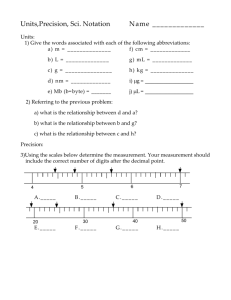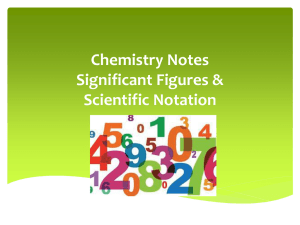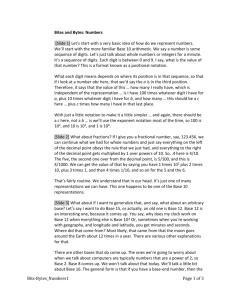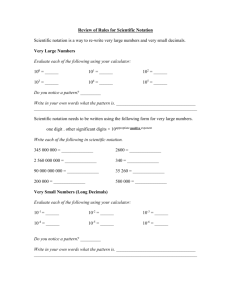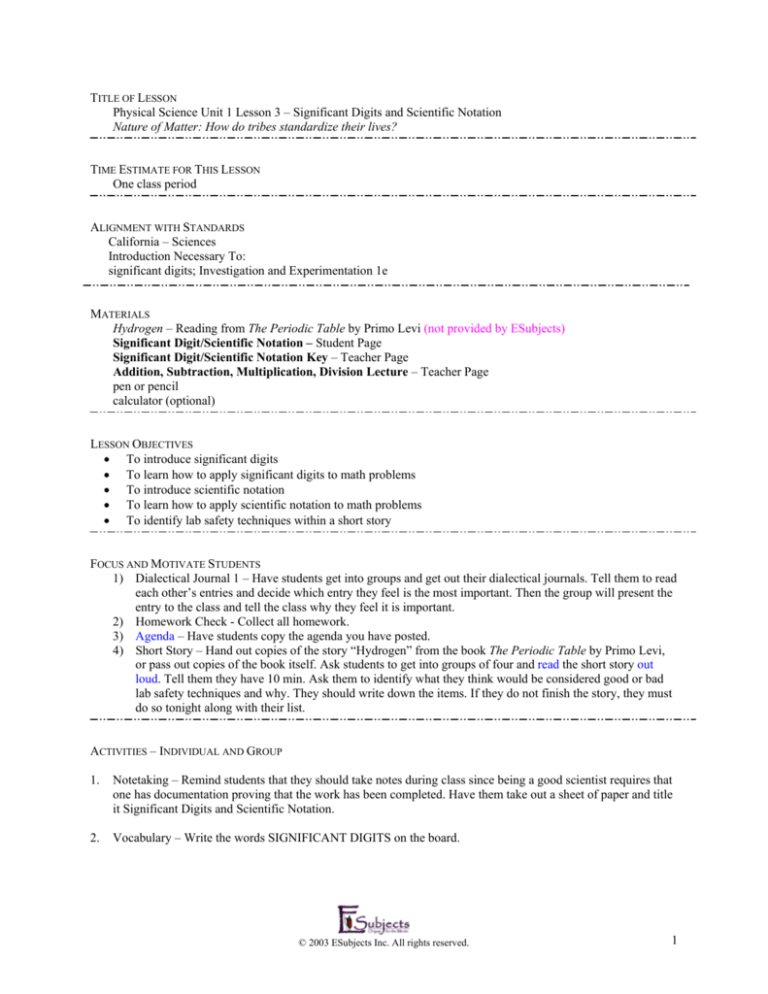
TITLE OF LESSON
Physical Science Unit 1 Lesson 3 – Significant Digits and Scientific Notation
Nature of Matter: How do tribes standardize their lives?
TIME ESTIMATE FOR THIS LESSON
One class period
ALIGNMENT WITH STANDARDS
California – Sciences
Introduction Necessary To:
significant digits; Investigation and Experimentation 1e
MATERIALS
Hydrogen – Reading from The Periodic Table by Primo Levi (not provided by ESubjects)
Significant Digit/Scientific Notation – Student Page
Significant Digit/Scientific Notation Key – Teacher Page
Addition, Subtraction, Multiplication, Division Lecture – Teacher Page
pen or pencil
calculator (optional)
LESSON OBJECTIVES
• To introduce significant digits
• To learn how to apply significant digits to math problems
• To introduce scientific notation
• To learn how to apply scientific notation to math problems
• To identify lab safety techniques within a short story
FOCUS AND MOTIVATE STUDENTS
1) Dialectical Journal 1 – Have students get into groups and get out their dialectical journals. Tell them to read
each other’s entries and decide which entry they feel is the most important. Then the group will present the
entry to the class and tell the class why they feel it is important.
2) Homework Check - Collect all homework.
3) Agenda – Have students copy the agenda you have posted.
4) Short Story – Hand out copies of the story “Hydrogen” from the book The Periodic Table by Primo Levi,
or pass out copies of the book itself. Ask students to get into groups of four and read the short story out
loud. Tell them they have 10 min. Ask them to identify what they think would be considered good or bad
lab safety techniques and why. They should write down the items. If they do not finish the story, they must
do so tonight along with their list.
ACTIVITIES – INDIVIDUAL AND GROUP
1.
Notetaking – Remind students that they should take notes during class since being a good scientist requires that
one has documentation proving that the work has been completed. Have them take out a sheet of paper and title
it Significant Digits and Scientific Notation.
2.
Vocabulary – Write the words SIGNIFICANT DIGITS on the board.
© 2003 ESubjects Inc. All rights reserved.
1
3.
Class Definition – Ask students to define each word. Write their ideas on the board. They may answer that
SIGNIFICANT means important, and DIGITS are numbers or fingers or toes. If they answer the latter, ask them
which would most likely be used in a scientific way. They should answer numbers. Remind them that in this
case digits or numbers relates to a scientific term. This is one way that we can determine if we are looking at a
scientific definition or a general definition. Then ask students, “Does anyone know anything about significant
digits? How many digits should your answer have? Is it always the same? Does it really matter? Why is it
important that measurements in labs be accurate?”
–Answers should include:
Different answers
depends on the precision of your measurement tool
No, depends on the precision of the measurement and the math involved
Yes, we want to be accurate in science with our values.
In order for results to be meaningful, the data must be taken accurately. There is a difference
between 10g and 10.0g; 10.0g is much more accurate.
4.
Graphic Organizer – Make a chart on the board. Discuss rules.
Rules for Determining Significant Digits
Rule
The following are always significant:
♦ all nonzero digits
♦ all zeros between nonzero digits
♦ zeros to the right of a nonzero digit and to the left of a decimal
♦ zeros to the right of a nonzero digit and to the right of a decimal
The following are never significant:
♦ zeros to the left of decimal in values less than one
♦ zeros to the right of decimal and to the left of the first nonzero
digit
Exceptions:
♦ exact conversion factors are understood to have unlimited sig digs
♦ counting numbers are understood to have unlimited sig digs
Example
456 has 3sig digs
70009 has 5 sig digs
10. has 2 sig digs
25.00 has 4 sig digs
0.876 has 3 sig digs
0.098 has 2 sig digs
100cm/1m –unlimited
30 days - unlimited
5.
Individual Work – Hand out copies of the Significant Digit and Scientific Notation worksheet. Have students
individually try the first few problems on the worksheet (problems 1-5). Tell them to write down the rule that
applies to each question. Randomly, ask students to give their answers and which rules they used to come up
with their answer. Go over any difficulties they may be having.
6.
Review and Discuss – Now introduce students to the rules when mathematics is applied.
Rules for Determining Significant Digits
when Applying Mathematics
Rules
Example
Addition and subtraction:
The answer must be rounded to contain the same number of digits to 2.71m + 0.0004m
the right of the decimal as there are in the measurement with the
=2.7104m
smallest number of digits to the right of the decimal.
=2.71m
Multiplication and division:
The answer must be rounded to contain the same number of digits as 5.6g x 2.345g
there are in the measurement with the smallest number of digits.
=13.132g
=13g
7.
Individual Work – Have students individually try the first few problems on the worksheet (problems 6-10).
8.
Review and Discuss – Now introduce students to the concept of applying mathematics to numbers written in
scientific notation, which you reviewed yesterday in class. Put the chart on the board and fill in as you go
through the explanations.
© 2003 ESubjects Inc. All rights reserved.
2
Rules for Applying Mathematics to Scientific Notation
Rules
Applying Scientific Notation:
Use scientific notation to eliminate all place holding zeros
Example
2400m → 2.4 x 103m
0.0005g → 5 x 10-4g
Addition and subtraction:
4.5 x 106 + 2.3 x 105
All values must have the same exponent before they can be added or =45 x 105 + 2.3 x 105
=47.3 x105
subtracted. The result is the sum or difference with the same
=4.7 x 106
exponent of 10.
Multiplication:
(4.5 x 106 )( 2.3 x 105)
The first factors of the number are multiplied and the exponents of
=(4.5 x 2.3) x 106+5
=10.35 x1011
10 are added.
=1.0 x 1012
Division:
(4.5 x 106 )/( 2.3 x 105)
The first factors of the number are divided and the exponents of 10
=(4.5 /2.3) x 106-5
=1.95652 x101
are subtracted.
=20.
Ask students how to convert the following number into scientific notation: 504900 = 5.049 x 105
Then using the Addition, Subtraction, Multiplication, and Division Lecture (Teacher Page) explain to
students the information on that sheet in relation to the chart above.
9.
Group Work – Have students break into lab groups and work on the rest of the Significant Digit and Scientific
Notation worksheet. Students should be challenged to complete as many significant digit and scientific notation
problems as possible. Walk around the room checking on students’ progress. Reward correct problem solving
technique and answers with sticker/stamp. Help students who are struggling. Remember ALL WORK MUST
BE SHOWN. Students will finish worksheet for homework.
10. Homework Review – Collect finished assignments and class notes. Go over the homework assignments.
HOMEWORK
1) Finish Significant Digit /Scientific and Scientific Notation worksheet
2) Finish reading the story “Hydrogen”
3) List good or bad lab safety practices from the story
GROUP ROLES
None
DOCUMENTATION FOR PORTFOLIO
None
© 2003 ESubjects Inc. All rights reserved.
3

